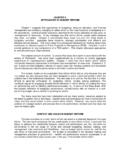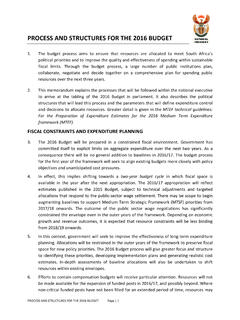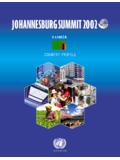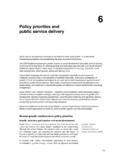Transcription of CHAPTER 3 LINKING POLICY, PLANNING AND BUDGETING …
1 31 CHAPTER 3 LINKING policy , PLANNING AND BUDGETING IN A MEDIUM-TERM FRAMEWORKI have so often maintained it in this House that I am almost ashamed to repeat it, butunfortunately it is not a principle which has yet entered into public opinion - expendituredepends on to UK House of Commons in 1862, Quoted in Heclo, 1981 This CHAPTER deals with LINKING policy , PLANNING and BUDGETING across the whole ofgovernment and at a sectoral level. The CHAPTER provides guidance on institutionalmechanisms that facilitate the allocation of resources to achieve strategic objectives. Affordability must influence policy making and PLANNING at the point when the decision is made.
2 Where adjustment is required to deal with changing macroeconomic conditions and, evenmore particularly, changing priorities, that adjustment needs to take place through policychange to be sustainable. A medium-term approach that encompasses all expenditureprovides a LINKING framework and facilitates the management of policies and budget realities toreduce pressure throughout the whole budget cycle. The result is better control of expenditureand greater efficiency and effectiveness in implementing policies, programs and projects. Thischapter provides guidance on approaches to some of these issues and improving theselinkages throughout the full cycle of policy , PLANNING and BUDGETING (Figure ).
3 WEAKNESSES THAT PRODUCE POOR BUDGETING OUTCOMESF ailure to link policy , PLANNING and BUDGETING may be the single most important factorcontributing to poor BUDGETING outcomes at the macro, strategic and operational levels indeveloping countries. In many countries, the systems are fragmented. policy making, PLANNING and BUDGETING take place independently of each other. PLANNING is often confined toinvestment activities, which in many developing countries refers to a series of donor-fundedprojects. Capital expenditures are already largely accounted for through the PLANNING process,and a large portion of recurrent expenditures are pre-committed to the wage bill. For thisreason, annual BUDGETING is reduced to allocating resources thinly across donor anddomestically funded investment projects and to the nonwage portion of the recurrent budget.
4 In addition, line agencies tend to budget and spend on an ad hoc basis because even smalldiscretionary allocations are rarely of funding, from one year to the next and within the budget year, is oneof many factors that contribute to the poor operational (level 3) performance of public sectors. Others that are related to the budget are the failure to direct resources to policy priorities - insignificant part because BUDGETING is treated as an annual funding exercise, not a policy -basedexercise - and the lack of authority and responsibility given to line managers to manageresources at their disposal. Other weaknesses lie largely outside the budget. Box inchapter 5 elaborates on the range of disincentives for sound operational (4)IMPLEMENT PLANNEDACTIVITIESC ollect revenues, release funds,deploy personnel,undertake activities(5)MONITOR activities andACCOUNT for expenditure(2)SET policy AND UNDERTAKEPLANNING ACTIVITYE stablish resource framework, setout objectives, policies, strategiesand expenditure priorities(3)MOBILIZE AND ALLOCATERESOURCESP repare Budget(1)REVIEW POLICYR eview the previous planningand implementation period(6)
5 EVALUATE and AUDITP olicy activities effectiveness andfeed the results into future plansFigure policy , PLANNING AND BUDGETING IN THEPLANNING AND RESOURCE MANAGEMENT CYCLEIn the absence of effective decision-making processes, policy making and PLANNING aredisconnected from each other and from BUDGETING , and they are not constrained by resourceavailability or by strategic priorities. Overall, this leads to a massive mismatch between what ispromised through government policies and what is affordable. The annual BUDGETING processtherefore becomes more about scrambling to keep things afloat, rather than allocatingresources on the basis of clear policy choices to achieve strategic policy , PLANNING AND BUDGETING IN THE PLANNING AND RESOURCEMANAGEMENT CYCLEI ntegrated policy , PLANNING and BUDGETING is fundamentally about having expenditureprograms that are driven by policy priorities and disciplined by budget realities.
6 The challengeis to manage the tension between "needs" and "availabilities" more effectively (Box ). Amedium-term approach provides such a LINKING framework and facilitates the management ofthe tension between policy and budget realities to reduce pressure throughout the wholebudget VERSUS AVAILABILITYIn many countries, BUDGETING has been undermined by the needs rather than "availability"psychology of the budget actors. While finance ministries stress "availability" (the revenues it expects to beforthcoming from domestic and external sources), line ministries persist in basing budget proposals on"needs." The result is a negative-sum budget process that undermines macroeconomic stability and programand project conflicting perspectives are understandable.
7 The Finance Ministry is constantly battling weakdomestic revenues, the debt servicing burden and mounting claims on budget resources. Since it hasresponsibility for the macroeconomic consequences of fiscal deficits, the MOF has no alternative but topreach the "availability message through tight budget ceilings. If a satisfactory budget cannot be prepared,it remakes the budget during implementation through the release of funds mechanism, at a high cost toproject and program efficiency. Line ministries build/inherit commitments they lack the resources to meet,yet must daily confront the consequences of inadequate allocations. Population growth, the running costs of newly completed projects, and unforeseen crises further pressure slender budgets.
8 Budget bids aresubmitted two to three times over finance ministry ceilings. When requested to concentrate resources onpriority programs, departments answer they have no mandate to cut service. Privately, they fear that tosubmit a lower bid within the ceiling would make them vulnerable to further cuts. The debate about "needs"makes no connection with using existing program allocations more countries where the gap between commitments and resources is so large, a satisfactory reduction isunlikely to come within the tight perspective of the annual budget. A more fundamental restructuring ofpublic expenditure has to take place engaging finance, PLANNING , line ministries and Cabinet (becauseintersectoral trade-offs have to be faced) in a process that has a medium-term perspective.
9 Donors, too, needto be involved because of their heavy contribution to budget financing. Availability, both domestic andaid, must be projected beyond a single year, and indicative shares communicated to departments. Needs must be prioritized and made consistent with the resource framework. All this must happen in a mannerthat encourages departments to re-examine commitments and their resourcing with central ministries in amore cooperative resource allocations based on a specific policy mix will be more predictablewhere a medium-term framework enforces discipline. Predictability allows line departments toplan and manage resources more efficiently within the time frame of the annual budget cycleand over the longer term.
10 The result is better control of public expenditures and better valuefor money within a hard predictability of resource flows and the criteria by which funding decisionsare made are the objective of the medium-term approach. In many developing countries, theresource allocation process is plagued by uncertainty, much of which is self-inflicted. Thecommon tendency to make overly optimistic revenue projections is one example of howgovernments themselves increase the uncertainty of resource flows (Box in CHAPTER 2). The complete mismatch between policy decisions and available resources is another source ofuncertainty, again self-inflicted because it could be avoided by implementing a rigorousprocess that links policy making, PLANNING and BUDGETING (Box ).

















